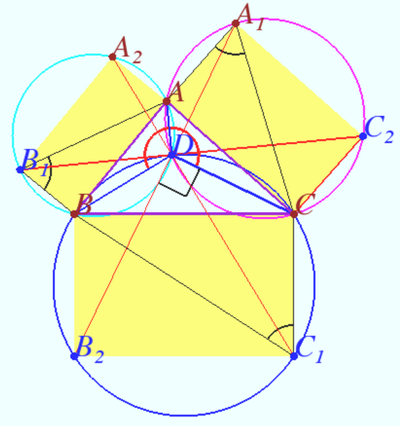Difference between revisions of "2021 USAMO Problems/Problem 1"
(The 2021 USAMO has not been out yet. Please do not edit this page. If you are a site admin, please delete this page.) |
(→Solution) |
||
| (3 intermediate revisions by 2 users not shown) | |||
| Line 1: | Line 1: | ||
| − | + | Rectangles <math>BCC_1B_2,</math> <math>CAA_1C_2,</math> and <math>ABB_1A_2</math> are erected outside an acute triangle <math>ABC.</math> Suppose that<cmath>\angle BC_1C+\angle CA_1A+\angle AB_1B=180^{\circ}.</cmath>Prove that lines <math>B_1C_2,</math> <math>C_1A_2,</math> and <math>A_1B_2</math> are concurrent. | |
| + | |||
| + | ==Solution== | ||
| + | [[File:2021 USAMO 1.png|400px|right]] | ||
| + | Let <math>D</math> be the second point of intersection of the circles <math>AB_1B</math> and <math>AA_1C.</math> Then | ||
| + | <cmath>\angle ADB = 180^\circ – \angle AB_1B,\angle ADC = 180^\circ – \angle AA_1C \implies</cmath> | ||
| + | <cmath>\angle BDC = 360^\circ – \angle ADB – \angle ADC =</cmath> | ||
| + | <cmath>= 360^\circ – (180^\circ – \angle AB_1B) – (180^\circ – \angle AA_1C) =</cmath> | ||
| + | <cmath>=\angle AB_1B + \angle AA_1C \implies \angle BDC + \angle BC_1C = 180^\circ \implies</cmath> | ||
| + | <math>BDCC_1B_2</math> is cyclic with diameters <math>BC_1</math> and <math>CB_2 \implies \angle CDB_2 = 90^\circ.</math> | ||
| + | Similarly, <math>\angle CDA_1 = 90^\circ \implies</math> points <math>A_1, D,</math> and <math>B_2</math> are collinear. | ||
| + | |||
| + | Similarly, triples of points <math>A_2, D, C_1</math> and <math>C_2, D, B_1</math> are collinear. | ||
| + | |||
| + | (After USAMO 2021 Solution Notes – Evan Chen) | ||
| + | |||
| + | '''vladimir.shelomovskii@gmail.com, vvsss''' | ||
| + | |||
| + | {{MAA Notice}} | ||
Revision as of 22:55, 18 October 2022
Rectangles ![]()
![]() and
and ![]() are erected outside an acute triangle
are erected outside an acute triangle ![]() Suppose that
Suppose that![]() Prove that lines
Prove that lines ![]()
![]() and
and ![]() are concurrent.
are concurrent.
Solution
Let ![]() be the second point of intersection of the circles
be the second point of intersection of the circles ![]() and
and ![]() Then
Then
![]()
![]()
![]()
![]()
![]() is cyclic with diameters
is cyclic with diameters ![]() and
and ![]() Similarly,
Similarly, ![]() points
points ![]() and
and ![]() are collinear.
are collinear.
Similarly, triples of points ![]() and
and ![]() are collinear.
are collinear.
(After USAMO 2021 Solution Notes – Evan Chen)
vladimir.shelomovskii@gmail.com, vvsss
The problems on this page are copyrighted by the Mathematical Association of America's American Mathematics Competitions. 










